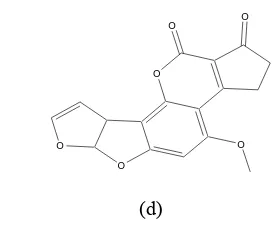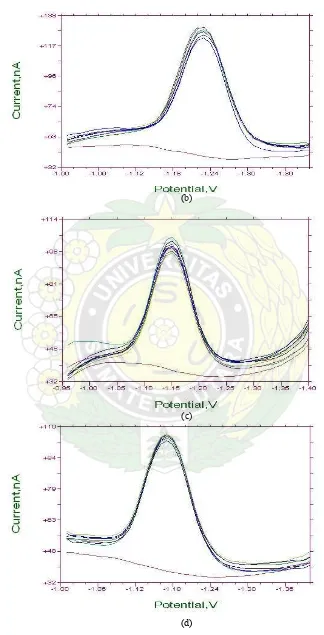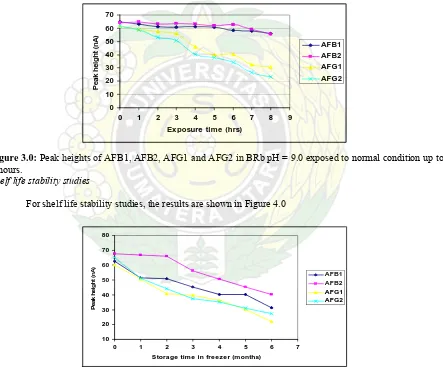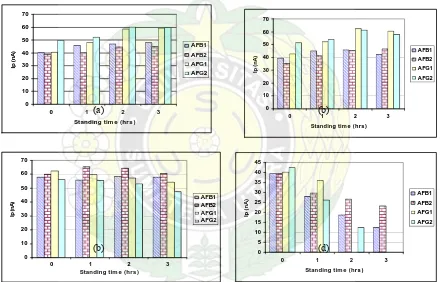APPLICATION OF DIFFERENTIAL PULSE CATHODIC
STRIPPING VOLTAMMETRIC TECHNIQUE IN STUDYING
STABILITY OF AFLATOXINS
Mohammad Hadzri Yaacob1, Abdull Rahim Hj.Mohd. Yusoff2, Rahmalan Ahamad2, Marpongahtun3
1
Scholl of Health Sceinces, USM, 16150 Kubang Krian, Kelantan, Malaysia
2
Dept.of Chemistry Faculty of Sciences, UTM, 81310 UTM, Skudai, Johor , Malaysia
3
Dept. of Chemistry, Faculty of Mathematic and Sciences, USU, Medan, Indonesia
Abstract
A stability studies of aflatoxins (AFB1, AFB2, AFG1 and AFG2 ) in Britton-Robinson buffer (BRb) using a Differential Pulse Cathodic Stripping Voltammetric (DPCSV) technique is described. The DPCSV was performed by cathodic potential scan through within the range of -950 to -1400 mV with 80s accumulation time using a BRb at pH 9.0 as the supporting electrolyte. The sampels were exposed for 0 to 8 hrs to normal laboratory condition before being scanned under optimised voltammetric parameters. Using the same procedure, aflatoxins in different pH of BRb were also studied after 0 to 3 hours exposed to the same condition. Other stability study was performed by scanning aflatoxins in BRb solution which were kept in freezer from first to six months of storage time. The results from these studies showed that AFB1 and AFB2 in BRb pH 9.0 were stable within 8 hours exposure time while AFG1 and AFG2 were stable up to a few hours. All aflatoxins scanned in BRB pH 6.0, 7.0 and 9.0 were more stable as compared when there were scanned in BRB pH 11.0 within 3 hours exposure time. The results also showed that the stability of the sampels which were prepared in BRB pH 9.0 was affected by longer storage time in freezer.
Keywords: AFB1, AFB2, AFG1, AFG2 compounds, stability studies and differential pulse cathodic stripping
voltammetry
INTRODUCTION
Aflatoxins are a group of secondary metabolites produced by Aspergillus flavus and Aspergillus parisiticus, which are found on crops and foodstuffs under certain conditions [[1]. Aflatoxins B1, B2, G1 and G2 have been found to be naturally and they display strong carcinogenicity. There are dangerous food contaminants and have been classified as Type I toxic materials by International Agency for Research Cancer (IARC) in 1984 [2]. Due to its toxicity, many countries have set stringent regulatory demands on the level of aflatoxins permitted and traded commodities. In our country, the regulatory levels for total aflatoxins in raw peanuts are 15 ppb and 5 ppb for other foodstuffs [3].Aflatoxins are not totally diminished by normal and cooking temperatures [4,5]. The chemical structures of AFB1, AFB2, AFG1 and AFG2 are shown in Figure 1.0 [6].
O
O O
O O
O
O
O O
O O
O
O
O O
O O
O
(a)
(b)
O
Figure 1.0: Chemical structures of (a) AFB1, (b) AFB2, (c) AFG1 and (d) AFG2
Many methods have been used for quantitative determination of aflatoxins includes thin layer chromatography (TLC) [7-9], high performance liquid chromatography (HPLC) with different type of detectors such as ultra-violet [10-12], fluorescence [13-15] and amperometer detectors [ 16]
In this study, all aflatoxins have been investigated for its stability in BRB pH 9.0 using DPSV technique. This technique was chosen rather than UV-VIS spectrophotometer because it uses the principle of the measurement of peak height of electro active species in sampel solution when potential was applied into it [17]. It can avoid problem arise from weak fluorescence property of AFB1 and AFG1 [16]. This technique also offers shorter time analysis compare to the HPLC technique [17].
In the present paper, we describe the results of stability studies on AFB1, AFB2, AFG1 and AFG2 which were prepared in BRB pH 9.0 and underwent hour to hour monitoring and also for shelf life of all aflatoxins in BRB pH 9.0 which was kept in fridge for six months.
MATERIAL AND METHOD
Reagents
All reagents employed were of analytical grade. Water purified from a Nano Pure Ultrapure water system ( Barnstead / Thermolyne) was used for all dilution and sampel preparation. Aflatoxins were purchased from SIGMA ( 1 mg per bottle ) and dissolved in benzene:acetonitrile (98:2) to produce 10 ppm standard solution each. The stock solutions were placed in small amber glass tubes and kept in a freezer at -4.0oC. The solution was measured under UV-VIS spectrometer for it absorbance at 365 +/- nm before being used for voltammetric analysis.
A stock solution of 0.04 M Britton-Robinson Buffer (BRB) solution was prepared as follows: 2.47 g boric acid (Fluka), 2.30 ml acetic acid (MERCK) and 2.70 ml
orthophosphoric acid ( Ashland Chemical ) were diluted to 1 l with deionised water. Britton-Robinson Buffer of pH 5, 7.0 and 11.0 were prepared by adding sodium hydroxide 1.0 M (MERCK) into the stock solution.. Hexadistilled mercury, grade 9 N, used in a control growth mercury electrode ( CGME ) stand, was purchased from MERCK. The purging was carried out with 99.99% nitrogen.
Instruments
A BAS CV-50W voltammetric analyser in connection with a CGME stand equipped with a three-electrode system and a 20 ml capacity BAS MR-1208 cell were used for all the voltammetric determination. The working electrode was a hanging mercury drop electrode (HMDE). A silver-silver chloride (Ag / AgCl) and a platinum wire were used as the reference and counter-electrode respectively. BAS CV-50W was connected to a computer for data processing. A pH meter Cyber-scan model equipped with a glass electrode combined with an Ag/AgCl reference electrode, was used for all pH measurements.
Procedure
General procedure
The general procedure used to obtain cathodic stripping voltammograms was as follows. A 10 ml aliquot of supporting electrolyte solution was put in a voltammographic cell. The stir was switched on and the solution was purged with nitrogen gas for at least 10 minutes. After forming a new HMDE, accumulate was effected for the required time at the appropriate potential while stirring the solution. At the end of the accumulation time the stirring was switched off and after 10 s had elapsed to allow the solution to become quiescent, the negative going potential was initiated. Ag/AgCl saturated was used as the reference electrode throughout this study.
Procedure for stability studies
For hour to hour stability studies, 312 ul, 315 ul, 328 ul and 330 ul of 1 ppm AFB1, AFB2, AFG1 and AFG2 standard solution in BRB pH 9.0 respectively were injected into 10 ml supporting electrolyte in the voltammetric cell separately and were scanned following the above stated procedures. Eight measurements have been made. The peak heights and peak potential of each aflatoxins were recorded. After these measurements, the aflatoxins standard solutions in voltammetric cell were exposed to normal laboratory condition without purging. Measurements were taken every hour up to 8 hours exposure time.
For shelf life stability studies, all aflatoxin standard solutions which were kept in freezer were subjected to the voltammetric measurement in BRb pH 9.0 every month up to 6 months keeping period.
For aflatoxins in different pH of BRB, the stability studies were performed by scanning aflatoxins solution (prepared in BRB pH 9.0) in four difference pH of BRB as the supporting electrolytes which were 6.0, 7.0, 9.0 and 11.0. The voltammetric determination procedures
were followed the same procedures as for the hour to hour stability studies except the exposure time was limited up to 3 hours.
RESULTS AND DISCUSSION
From our previous experiment using a cyclic voltammetry technique , AFB1, AFB2, AFG1 and AFG2 show an irreversible reduction peak at -1235 +/- 10 mV, ( all against Ag/AgCl) respectively [18, 19]. Based on this electro active property, differential pulse cathodic stripping voltammetry (DPCSV) technique was applied in this study.
Voltammograms of aflatoxins
The voltamograms of 0.1 uM AFB1, AFB2, AFG1 and AFG2 scanned in BRb pH = 9.0 are shown in figures 2.0a -2.0d. Replicate measurements of peak height of respective aflatoxins give the repeatability results of 63.19 nA, 65.67 nA, 60.76 nA and 61.79 nA respectively with coefficient variation of 1.50 to 2.60% for all aflatoxins. The results show that the DPSV technique give high consistent results with very small error and could be applied in stability studies of aflatoxins.
(b)
(c)
(d)
0
Hour to hour stability studies;
The results of these studies using 0.10 uM AFB1, AFB2, AFG1 and AFG2 in BRB pH 9.0 are represented in Figure 3.0.
The results show that AFB1 and AFB2 in BRb pH 9.0 were stable within 8 hours exposure time where the peak heights for both aflatoxins were reduced only 15%. In contrast, AFG1 and AFG2 gave significant reduced of peak heights within the same period of exposure time where the peak height of AFG1 and AFG2 were reduced to 50% and 58% respectively. The results show that AFG1 and AFG1 were less stable in BRb pH 9.0 as compared to AFB1 and
AFB2. Based on their chemical structures, the most reactive functional groups for ease of attack by chemical reagents are two lactones rings of AFB1 and AFG1 and cyclopentanone rings in AFB2 and AFG2. These lactones can be readily opened by hydrolysis with strong alkalis such as sodium hydroxide. Other functional group of this aflatoxin is less readily attacked by chemical reagents. The methyl ether and furan ether groups would be cleaved only by very strong acids such as hydriodic acid. The double bond of terminal furan rings of AFB1 and AFG1 are susceptible to attack by electrophilic reagents and can be reduced or oxidised [20].
Figure 3.0: Peak heights of AFB1, AFB2, AFG1 and AFG2 in BRb pH = 9.0 exposed to normal condition up to 8 hours.
Shelf life stability studies
For shelf life stability studies, the results are shown in Figure 4.0
Figure 4.0: Peak heights of aflatoxins in BRb pH 9.0 which were kept up to 6 months in freezer.
The results showed that after three months storage in freezer, the peak heights of AFG1 and AFG2 in BRB pH 9.0 were decreased to about 70% from original peak height measured at first day of preparation. AFB2 was the most stable within 2 months keeping period. These results revealed that AFB1 and AFB2 were stable within 3 months
kept in fridge but gradually decreased after that time. Peak heights of AFG1 and AFG1 were gradually decreased since first month keeping time up to 6 months.
0
acid and neutral conditions, peak heights of all aflatoxins were increased when the exposure time were longer. In BRb pH 9.0, the peak heights were not significantly affected by longer exposure time. This phenomenon may be because of all aflatoxins need enough time to be completely dissolved in acid and neutral condition compared in basic medium. In strong base, the peak height was significantly decreased where AFG2 has not given any peak after 3 hours exposure time. These results indicate that in neutral and acid conditions, aflatoxins take time to stabilise themselves and at strong base, it was slowly reacted while cyclopentanone and lactone groups slowly
damaged (21). AFG1 and AFG2 show decreasing in peak height faster than aFB1 and AFB2. This was due to the easy of lactones group in both compounds attacked in strong basic condition compared to acidic condition. Other chemical group was not affected in acid or neutral medium as can be observed from the peak heights of all aflatoxins in BRB pH 6.0 and 7.0 within 3 hours standing time. At 0 hrs standing time, the peak heights of all aflatoxins in BRB pH 6.0, 7.0 and 11.0 were lower as compared in BRb pH 9.0 due to those pH were not an optimum pH for DPCSV analysis of aflatoxins as found in our previous experiment [22].
(a) (b)
(b) (d)
Figure 4.0: Peak heights of 0.1 uM aflatoxins in BRb at pH (a) 6.0, (b) 7.0, (c) 9.0 and (d) 11.0 exposed to normal laboratory condition up to 3 hrs standing time
CONCLUSION
Using DPCSV technique, stability studies of aflatoxins have been successfully performed. It was concluded that AFB1 and AFB2 in BRb pH 9.0 which were exposed to normal condition were more stable as compared to AFG1 and AFG2 in the same medium. Shelf life of AFB1 and AFB2 keeping in freezer were longer compared to AFG1 and AFG2. All aflatoxins in BRb pH 6.0, 7.0 and 9.0 which were exposed to normal condition up to three hours were stable but in BRb pH 11.0, their peak heights were significantly decreased.
REFERENCES
Begum F and Samajpathi N (2000), Mycotoxin production in rice, pulses and oilseeds,Naturwissenschaften, 87: 275-277
International Agency for Research on Cancer (1993) IARC monographs on the evaluation of carcinogenic risk to humans, vol. 56. World Health Organisation, Lyon.
Creepy E.E (2002). Update of survey, regulation and toxic effect of mycotoxins Europe, Toxicology Letter, 127: 19-28 Samarajeewa U., Sen A.C., Cohen M.D. and
Wei C.L (1990). Detoxification of Aflatoxins in foods and feeds by physical and chemical methods Food Protection, 53, 489-501.
Goldblatt L.A (1969) Aflatoxin: Scientific background, control and implication, Academic Press, New York.
Gimeno A. and Martins M. L (1983) Rapid thin layer chromatographic determination of patulin, citrinin and aflatoxin in apples and pears and their juices and jams, J. Assoc. Anal. Chem., 66, 85-91.
Bicking M.K.L., Kniseley R.N and Svec H.J (1983), Coupled-Column for quantitating low levels of aflatoxins, J. Assoc. Off. Anal. Chem., 66, 905-908.
Tutour L.B., Elaraki A. T. and Aboussalim A.,(1984). Simultaneous thin layer chromatographic determination of aflatoxin B1 and ochratoxin A in black olives, J Assoc Off Anal Chem., 67: 611-620.
Rastogi S., Das M. and Khanna S.K. (2001). Quantitative determination of aflatoxin B1-oxime by column liquid chromatography with ultraviolet detection. J Of Chromatography A, 933: 91-97.
Joshua, H (1993) Determination of aflatoxin by reversed-phase high performance liquid chromatography with post-column in-line photochemical derivatization and fluorescence detection, J. Chromatography A., 654: 247-254. Miller N, Pretorius H.E. and Trinder D.W
(1985). Determination of aflatoxins in vegetable oils, J. Assoc. Off. Anal. Chem., 68: 136-137.
Scholten J.M and Spanjer M.C (1996) Determination of aflatoxin B1 in pistachio kernels and shells, J. Assoc. Off. Anal. Chem., 79: 1360-1364.
Brera C., Caputi R., Miraglia M., Iavicoli I., Salerno A. and Carelli G. (2002). Exposure assessment to mycotoxins in workplace: aflatoxins and ochratoxin A occurrence in airborne dusts and human sera, Micro Chemical J. (uncorrected proof).
Garcia-Villanova R.J., Cordon C., Paramas A.M.G., Aparicio P. and Rosales M.E.G., (2004). Simultaneous immunoaffinity column clean up and HPLC analysis of aflatoxins and ochratoxin A in Spanish
bee pollen, J Agric. Food Chem., 52; 7235-7239.
Gonzalez M.P.E., Mattusch J. and Wennrich R ( 1998) Stability and determination of aflatoxins by high-performance liquid chromatography with amperometric detection, J.Chromatography A, 828: 439-444.
Fifield F.W. and Kealey D (2000) Principle and practice of analytical chemistry 3rd Edition, Blackwell Science, UK.
Yaacob M.H., Mohd Yusof A.R., and Ahamad R (2003), Cyclic Voltammetry of AFB2 at mercury electrode, Paper presented at SKAM –VI, Unimas, Kucing, Sarawak, Malaysia, 9-11 September 2003. Yaacob M.H., Mohd Yusof A.R., and Ahamad
R. (2004), Cyclic Voltammetry of AFG1 at mercury electrode, Paper presented at 3rd Annual Seminar on Sustainable Science and Management, KUSTEM, Terengganu, Malaysia, 4 – 5 May 2004. Jaimez J., Fente C.A., Vazquez B.I., Franco
C.M., Cepeda A., Mahuzier G. and Prognon P (2000). “Application of the assay of aflatoxins by liquid chromatography with fluorescence detection in food analysis.” J. Chromatography A, 882: 1-10.
Miller K (1987) Toxicology aspects of food. Elsevier Applied Science, New York. Yaacob M.H., Mohd Yusof A.R. and Ahamad R
(2005). Differential pulse stripping voltammetric (DPSV) technique for determination of AFB2 at the mercury electrode. To be published in Collection of Czechoslovak Chemical



